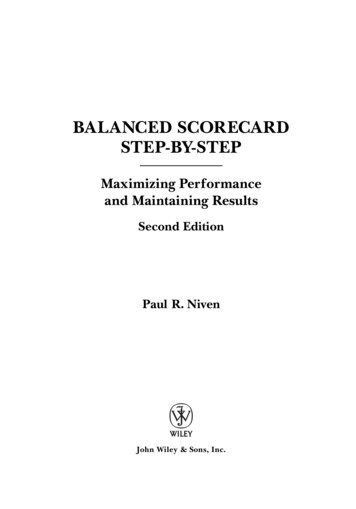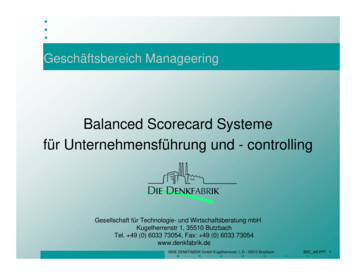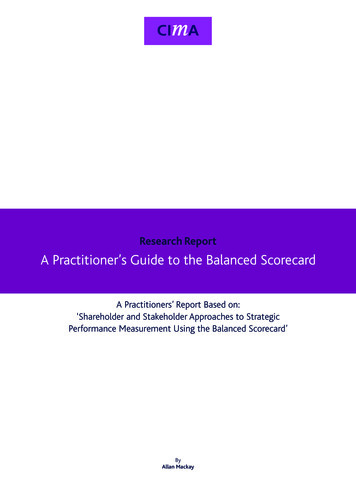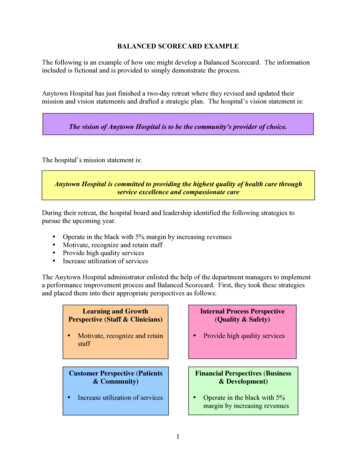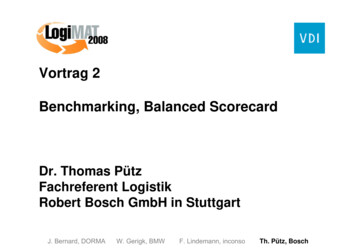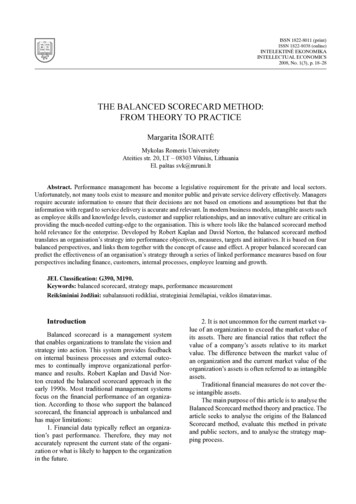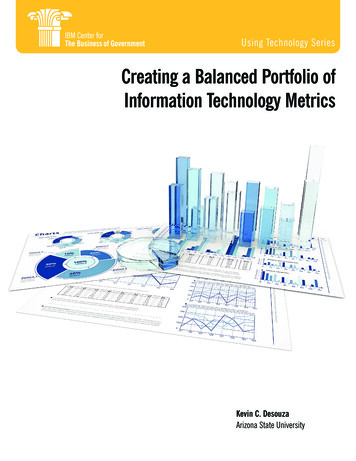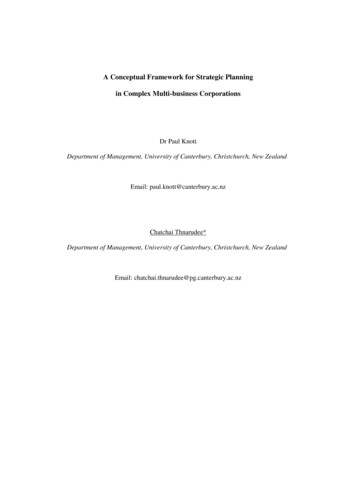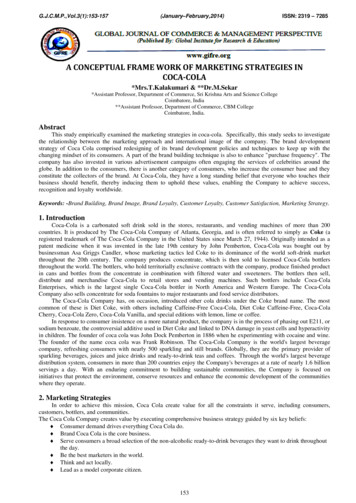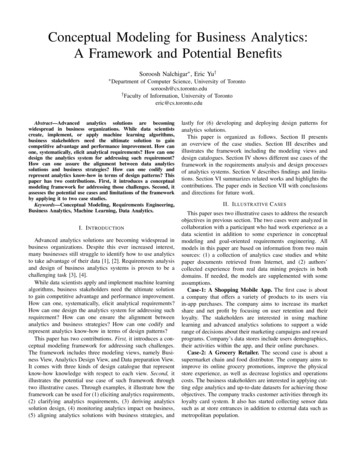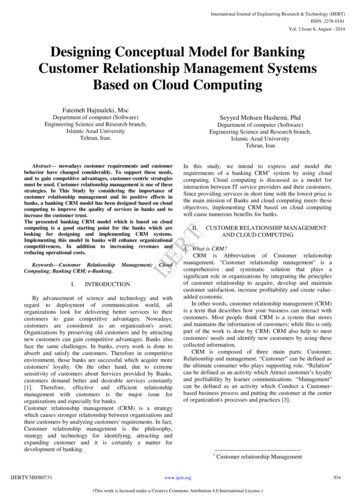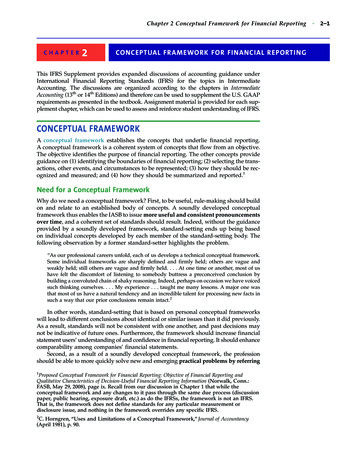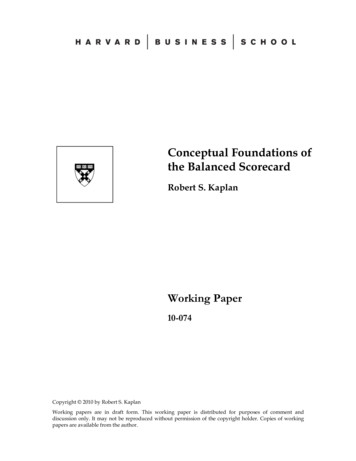
Transcription
Conceptual Foundations ofthe Balanced ScorecardRobert S. KaplanWorking Paper10-074Copyright 2010 by Robert S. KaplanWorking papers are in draft form. This working paper is distributed for purposes of comment anddiscussion only. It may not be reproduced without permission of the copyright holder. Copies of workingpapers are available from the author.
Conceptual Foundations of the Balanced Scorecard1Robert S. KaplanHarvard Business School, Harvard University1Paper originally prepared for C. Chapman, A. Hopwood, and M. Shields (eds.), Handbook ofManagement Accounting Research: Volume 3 (Elsevier, 2009).1
Conceptual Foundations of the Balanced ScorecardAbstractDavid Norton and I introduced the Balanced Scorecard in a 1992 Harvard BusinessReview article (Kaplan & Norton, 1992). The article was based on a multi-company researchproject to study performance measurement in companies whose intangible assets played a centralrole in value creation (Nolan Norton Institute, 1991). Norton and I believed that if companieswere to improve the management of their intangible assets, they had to integrate the measurementof intangible assets into their management systems.After publication of the 1992 HBR article, several companies quickly adopted theBalanced Scorecard giving us deeper and broader insights into its power and potential. During thenext 15 years, as it was adopted by thousands of private, public, and nonprofit enterprises aroundthe world, we extended and broadened the concept into a management tool for describing,communicating and implementing strategy. This paper describes the roots and motivation for theoriginal Balanced Scorecard article as well as the subsequent innovations that connected it to alarger management literature.2
“Conceptual Foundations of the Balanced Scorecard”Robert S. KaplanDavid Norton and I introduced the Balanced Scorecard in a 1992 HarvardBusiness Review article.1 The article was based on a 1990 Nolan, Norton multi-companyresearch project that studied performance measurement in companies whose intangibleassets played a central role in value creation.2 Our interest in measurement for drivingperformance improvements arose from a belief articulated more than a century earlier bya prominent British scientist, Lord Kelvin:3I often say that when you can measure what you are speaking about, and expressit in numbers, you know something about it; but when you cannot measure it,when you cannot express it in numbers, your knowledge is of a meager andunsatisfactory kind.If you can not measure it, you can not improve it.Norton and I believed that measurement was as fundamental to managers as it was forscientists. If companies were to improve the management of their intangible assets, theyhad to integrate the measurement of intangible assets into their management systems.After publication of the 1992 HBR article, several companies quickly adopted theBalanced Scorecard giving us deeper and broader insights into its power and potential.During the next 15 years, as it was adopted by thousands of private, public, and nonprofitenterprises around the world, we extended and broadened the concept into a managementtool for describing, communicating and implementing strategy. In this paper, I describethe roots and motivation for the original Balanced Scorecard article as well as thesubsequent innovations that connected it to a larger management literature. The paperuses the following structure for organizing the origin and subsequent development of theBalanced Scorecard:1. Balanced Scorecard for Performance Measurement2. Strategic Objectives and Strategy Maps3. The Strategy Management System4. Future Opportunities3
Balanced Scorecard for Performance MeasurementFigure 1 shows the original structure for the Balanced Scorecard (BSC). The BSC retainsfinancial metrics as the ultimate outcome measures for company success, but supplements thesewith metrics from three additional perspectives – customer, internal process, and learning andgrowth – that we proposed as the drivers for creating long-term shareholder value.Figure 1: Translating Vision and Strategy: Four PerspectivesFINANCIAL“To succeedfinancially,how should weappear to tivesINTERNAL BUSINESS PROCESSCUSTOMER“To achieve our Objectivesvision, howshould weappear to ourcustomers?”MeasuresTargetsInitiatives“To satisfy ourshareholdersand customers,what businessprocesses mustwe excel at?”Vision RNING AND GROWTH“To achieve our Objectivesvision, howwill we sustainour ability tochange andimprove?”MeasuresTargetsInitiatives1.1. Historical Roots: 1950-1980The Balanced Scorecard, of course, was not original for advocating that nonfinancialmeasures be used to motivate, measure, and evaluate company performance. In the 1950s, aGeneral Electric corporate staff group conducted a project to develop performance measures for4
GE’s decentralized business units (Lewis, 1955).2 The project team recommended that divisionalperformance be measured by one financial and seven nonfinancial metrics.1. Profitability (measured by residual income)2. Market share3. Productivity4. Product leadership5. Public responsibility (legal and ethical behavior, and responsibility tostakeholders including shareholders, vendors, dealers, distributors, andcommunities)6. Personnel development7. Employee attitudes8. Balance between short-range and long-range objectivesOne can see the roots of the Balanced Scorecard in these eight objectives. The financialperspective is represented by the first GE metric, the customer perspective with the second, theprocess perspective with metrics 3 -5, and the learning and growth perspective with metrics 6 and7. The 8th metric captures the essence of the Balance Scorecard, encouraging managers to achievea proper balance between short and long-range objectives. Unfortunately, the noble goals of the1950s GE corporate project never got ingrained into the management system and incentivestructure of GE’s line business units. In fact, despite metrics 5 and 8 in the above list, several GEunits were subsequently convicted of price-fixing schemes, with their managers claiming thatcorporate pressure for short-term profits led them to compromise long-term objectives and theirpublic responsibilities.At about the same time as the GE project, Herb Simon and several colleagues at thenewly-formed Graduate School of Industrial Administration, Carnegie Institute of Technology(later Carnegie-Mellon University) identified several purposes for accounting information inorganizations:Scorecard questions: “Am I doing well or badly?”Attention-directing questions: “What problems should I look into?”Problem-solving questions: “Of the several ways of doing the job, which is thebest?2See also, General Electric (A), HBS Case Study5
Simon and his colleagues explored the role for financial and nonfinancial information to informthese three questions. This study was perhaps the first to introduce the term “scorecard” into theperformance management discussion.Peter Drucker introduced management by objectives in his classic 1954 book, ThePractice of Management. Drucker argued that all employees should have personal performanceobjectives that aligned strongly to the company strategy:Each manager, from the “big boss” down to the production foreman or the chiefclerk, needs clearly spelled-out objectives. These objectives should lay out whatperformance the man’s [sic] own managerial unit is supposed to produce. Theyshould lay out what contribution he and his unit are expected to make to helpother units obtain their objectives. [ ] These objectives should always derivefrom the goals of the business enterprise. [ ] [M]anagers must understand thatbusiness results depend on a balance of efforts and results in a number of areas.[ ] Every manager should responsibly participate in the development of theobjectives of the higher unit of which his is a part. [ ] He must know andunderstand the ultimate business goals, what is expected of him and why, whathe will be measured against and how (Drucker 1954, pp. 126-9).Despite Drucker’s insights and urgings, however, management by objectives in the next halfcentury mostly became a somewhat bureaucratic exercise, administered by the human resourcesdepartment, based on local goal-setting that was operational and tactical, and rarely informed bybusiness-level strategies and objectives. Companies at Drucker’s time and for many yearsthereafter lacked a clear way of describing and communicating top-level strategy in a way thatmiddle managers and front-line employees could understand and internalize.In the mid-1960s, Robert Anthony, building upon the decade-earlier research by Simon etal, and on another article by Simon on programmed versus nonprogrammed decisions, proposed acomprehensive framework for planning and control systems. Anthony identified three differenttypes of systems: strategic planning, management control, and operational control. Strategicplanning was defined as:the process of deciding upon objectives, on changes in these objectives, on theresources used to attain these objectives, and on the policies that are to governthe acquisition, use, and disposition of these resources (Anthony 1965, p.16).Foreshadowing the subsequent development of strategy maps, Anthony claimed that strategicplanning depends “on an estimate of a cause-and-effect relationship between a course of actionand a desired outcome,” but concluded that, because of the difficulty of predicting such arelationship, “strategic planning is an art, not a science.” Further, Anthony noted that strategic6
planning is not accompanied by what we would today call strategic control, “Although strategicrevision is important, top management spends relatively little time in this activity.” Anthony alsobelieved that information for strategic planning usually had a financial emphasis.Anthony’s second category, management control, concerned “the process by whichmanagers assure that resources are obtained and used effectively and efficiently in theaccomplishment of the organization’s objectives” (Anthony 1965, p. 17). He observed thatmanagement control systems, with rare exceptions, have an underlying financial structure; that is,plans and results are expressed in monetary units the only common denominator by means ofwhich the heterogeneous elements of outputs and inputs can be combined and compared. Heacknowledged, however,Although management control systems have financial underpinnings, it does notfollow that money is the only basis of measurement, or even that it is the mostimportant basis. Other quantitative measurements, such as [ ] market share,yields, productivity measures, tonnage of output, and so on, are useful. (Anthony1965, p. 42)Anthony described the third category, operational or task control, as “the process ofassuring that specific tasks are carried out effectively and efficiently.” He stated that informationfor operational control was mostly nonmonetary, though some information could be denominatedin monetary terms (presumably, frequent variance reports on labor, machine, and materialsquantity and cost variances).Thus the roots of management planning and control systems encompassing both financialand nonfinancial measurement can be seen in these early writings of Simon, Drucker, andAnthony. Despite the advocacy of these scholars, however, the primary management system formost companies, until the 1990s, used financial information almost exclusively and relied heavilyon budgets to maintain focus on short-term performance.1.2. Japanese Management Movement: 1975-1990During the 1970s and 1980s, innovations in quality and just-in-time production byJapanese companies challenged the Western leadership in many important industries. Severalauthors argued that Western companies’ narrow focus on short-term financial performancecontributed to their complacency and slow response to the Japanese threat. Johnson and Kaplan(1987) reviewed the history of management accounting and concluded that US corporations hadbecome obsessed with short-term financial measures and had failed to adapt their management7
accounting and control systems to the operational improvements from successful implementationof total quality and short-cycle-time management.A Harvard Business School project on Council on Competitiveness (Porter, 1992) echoedthese critiques when it identified the following systematic differences between investments madeby US corporations versus those made in Japan and Germany:The US system is less supportive of investment overall because of its sensitivity tocurrent returns combined with corporate goals that stress current stock price overlong-term corporate value.The US system favors those forms of investment for which returns are most readilymeasurable. This explains why the United States underinvests, on average, inintangible assets [N.B., product and process innovation, employee skills, customersatisfaction] where returns are more difficult to measure.The US system favors acquisitions, which involve assets that can be easily valued overinternal development projects that are more difficult to value. (Porter, 1992, p. 72-73).Some accounting academics proposed methods by which a firm’s spending to createintangible assets could be capitalized and placed as assets on the corporate Balance Sheet. Duringthe 1970s, there was a burst of interest in human resources accounting (Flamholtz, 1974; Caplanand Landekich, 1975; Grove et al, 1977). Subsequently, Baruch Lev and his doctoral students andcolleagues proposed that financial reporting could be more relevant if companies capitalized theirexpenditures on intangible assets or found other methods by which these assets could be placedon corporate Balance Sheets. While such a treatment is consistent with Lord Kelvin’s (and our)advocacy of measurement to improve und
Balanced Scorecard giving us deeper and broader insights into its power and potential. During the next 15 years, as it was adopted by thousands of private, public, and nonprofit enterprises around the world, we extended and broadened the concept into a management tool for describing, communicating and implementing strategy. In this paper, I describe the roots and motivation for the original .
